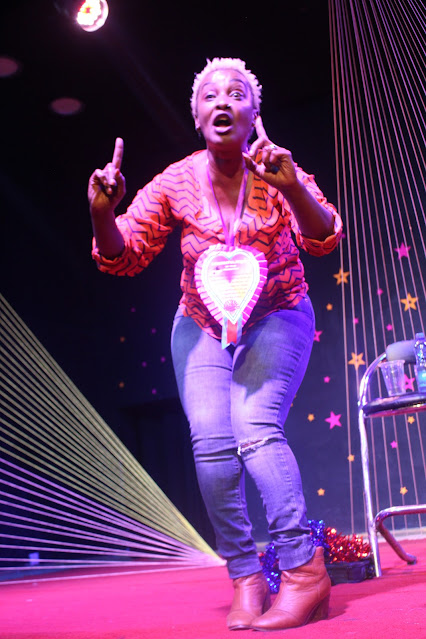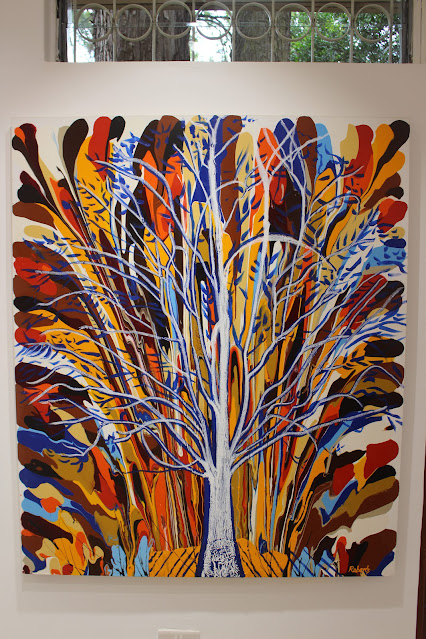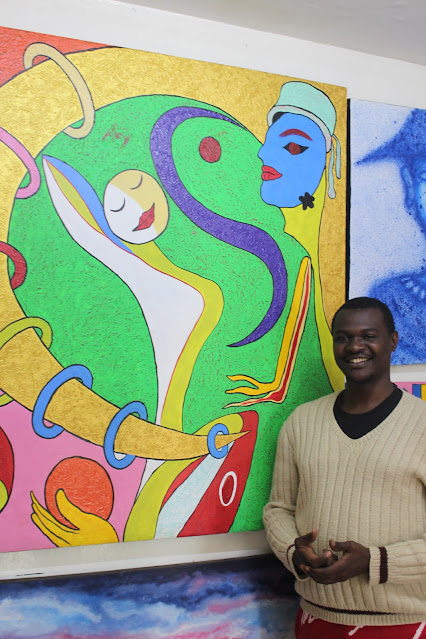Anthony Okello
has been described as “one of the most important artists of his generation.” I
would go further and say Okello is one of the most important artists in the
region, especially for his epoch series of paintings which examined the
mythologies and cultural identities of several Kenyan communities, namely the Luo,
Kikuyu, and Taita people.
Taking on
the role of cultural chronicler was a challenge Okello has relished, even if he
didn’t identify himself as such. His ‘Masquerade Series’ projected an idiom
that resonated well with the political and social climate of the times, when
duplicity was all-pervasive, and masks were meant to hide the criminality of
crooks in high office.
Okello’s latest
series of works is in his current solo show at One Off Gallery entitled ‘Between
Losing and Finding’.
In his
typically elusive style, he doesn’t explain what his title “Which Side?” refers
to. “It could be many things,” he says. It might refer to politics, religion, ethnicity,
or any other contested topic that wafts through the cultural atmosphere at any
time. “It’s true, I’m not done with this series,” he adds.
The series
definitely leaves one wondering what do all of these portraits have in common?
They are all men, one wearing a Muslim cap, one a young man in a chartreuse
t-shirt, one a businessman wearing a three-piece suit, one in a straw hat, and one
in a bright orange vest.
That struggle
is best expressed in his oil painting entitled ‘Heaviness’. It’s the first one
you see as you walk into The Loft and see a beautifully beheaded body wearing a
black, red, and gold striped suit. It doesn’t instantly hit you that the
stripes are meant to suggest someone’s in jail. But the more one ponders the
painting, one sees two shadowy beings in the background of the work. “They
exist in the mind of the [beheaded] one,” Okello says, giving us a hint that
the one wearing the stipes is himself, and the two behind might be the spirit
of those whom he’s lost. Their loss is apparently the basis of the ‘heaviness’ of
his heart and the reason he’s named this particular painting.
At the other
end of the gallery is ‘Entertainers on Tour’. Filled with musical cows,
including several crooning through their microphones, it looks antithetical to the
previous painting which registers pain while this one resounds with pleasure.
“I’m living in
Athi River where there are lots of musicians around who are always making
music,” he says. “I think that’s where that painting came from,” he guesses.
Nonetheless, he’s almost apologetic about the work. “I’m only using color in
the piece to cover up what I’m really feeling,” he adds, alluding to the muted
hues in the painting.
“What’s more
important than color is light and dark,” he continues. “It’s about black and
white. Life itself is never about color; it’s about shading.”
So Okello now
speaks as someone who has picked a side, the side of shading over color. Yet virtually all the works in this show are
suffused with color. Okello has a point, however, if one examines a work like ‘Prayer
Pearls’ in which the white pearls have the greatest impact in a painting that
is otherwise dark. In ‘Their Glorious Selves’, all eyes are instantly drawn to
the man with the white turban and to the whites in his and his friend’s eyes.
Yet some of
us who knew his work 15 years back will disagree with Okello. That was when he
was painting his surrealistic mythologies and telling visual stories that made
us hope he’d do the same for all the communities in Kenya, which someday maybe
he will.
















.JPG)


.jpg)


















